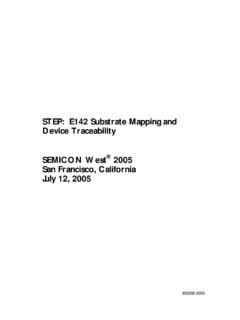Transcription of MAPPING CHOICES - sealevel.climatecentral.org
1 MAPPING CHOICES . CARBON, CLIMATE, AND RISING SEAS. OUR GLOBAL LEGACY. November 2015. This page intentionally blank MAPPING CHOICES . CARBON, CLIMATE, AND RISING SEAS. OUR GLOBAL LEGACY. ABOUT CLIMATE CENTRAL. Climate Central surveys and conducts scientific research on climate change and informs the public of key findings. Our scientists publish and our journalists report on climate science, energy, sea level rise, wildfires, drought, and related topics. Climate Central is not an advocacy organization. We do not lobby, and we do not support any specific legislation, policy or bill. Climate Central is a qualified 501(c)3 tax-exempt organization. Climate Central scientists publish peer-reviewed research on climate science; energy; impacts such as sea level rise; climate attribution and more.
2 Our work is not confined to scientific journals. We investigate and synthesize weather and climate data and science to equip local communities and media with the tools they need. November 2015. Princeton: One Palmer Square, Suite 330 Princeton, NJ 08542. Phone: +1 609 924-3800. Toll Free: +1 877 4-CLI-SCI / +1 (877 425-4724). Cover: Image shows night lights on land that could be submerged by long-term sea level rise after 4 C warming. Night lights satellite imagery data source: NASA. 2 MAPPING CHOICES . REPORT AUTHORS. BENJAMIN H. STRAUSS, PhD, Lead Vice President for Sea Level Rise and Climate Impacts, Climate Central Dr. Strauss is the Vice President for Sea Level Rise and Climate Impacts at Climate Central, and the founder and scientific and creative driver behind Surging Seas.
3 He has published multiple peer- reviewed papers on sea level rise, which have been downloaded more than 40,000 times; testified before the Senate; and led development of the suite of sea level and coastal flood risk maps, tools, and visualizations. This research and creative work have led to coverage in more than 2,000 news stories including multiple front-page articles in the New York Times and Washington Post, and repeat appearances for Strauss on NBC, CBS, PBS and NPR national programming. He holds a in Ecology and Evolutionary Biology from Princeton University, an in Zoology from the University of Washington, and a in Biology from Yale University. SCOTT KULP, PhD. Computational Scientist and Senior Developer, Climate Central Dr.
4 Scott Kulp serves as Computational Scientist and Senior Developer for Climate Central's Program on Sea Level Rise, where his research interests include the impacts of sea level rise on coastal communities. Scott holds a in Computer Science from Rutgers University for his work on the topic of cardiac blood flow simulations. Previously, Dr. Kulp has worked for the Department of Defense on several research projects, such as the simulation of iris tissue deformation and GPU- accelerated neural networks. ANDERS LEVERMANN, PhD. Co-chair of the Research Domain Sustainable Solutions at Potsdam Institute for Climate Impact Research and Physics Professor at Potsdam University, Germany Anders Levermann is a climate scientist and physics professor.
5 He was a lead author of the sea-level chapter of the latest climate report. His research focuses on large-scale abrupt changes with potentially strong impacts on nature and society, in systems ranging from the Antarctic ice sheet to ocean dynamics to monsoon rainfall. Since 2012 he has led research on global adaptation strategies at the Potsdam Institute, developing an economic damage propagation model for the global production and supply network. Prof. Levermann has published more than 80 scientific papers, and advises government representatives, members of parliament, political parties, economic stakeholders and journalists with respect to climate change issues. 3 MAPPING CHOICES . ACKNOWLEDGMENTS. We thank Mark Merrifield for providing high-resolution model outputs of global high tide levels in support of this research, and we thank Claudia Tebaldi, Stanley Jacobs, Nathan Gillett, and Michael Oppenheimer for the contributions they made to our thinking as we wrote the paper upon which this report is based, in the Proceedings of the National Academy of sciences United States of America.
6 We also thank Climate Central's financial supporters for this project and the sea level rise program: the V. Kann Rasmussen Foundation, The Kresge Foundation, The Schmidt Family Foundation, and others. SUGGESTED CITATION. Strauss, B. H., Kulp, S. and Levermann, A. 2015. MAPPING CHOICES : Carbon, Climate, and Rising Seas, Our Global Legacy. Climate Central Research Report. pp. 1-38. 4 MAPPING CHOICES . CONTENTS. Executive Summary 6. Introduction and Approach 7. Sea Level Projections 7. Elevation Analysis and Maps 8. Population Analysis 9. Global Coast, Nations and Cities at Risk 10. Detailed Methods 17. References 19. Appendix 21. 5 MAPPING CHOICES . EXECUTIVE SUMMARY. Carbon emissions causing 4 degrees Celsius of warming ( degrees Fahrenheit) a business-as- usual scenario could lock in enough eventual sea level rise to submerge land currently home to 470 to 760 million people globally.
7 Carbon cuts resulting in the proposed international target of 2 C. warming ( F) would reduce the rise locked in so that it would threaten areas now occupied by as few as 130 million people. This contrast is one expression of what is at stake in the December 2015. global climate talks in Paris. This report builds closely on a paper first published online in October 2015 in the Proceedings of the National Academy of sciences of the United States of America by the same authors. That research used relationships between cumulative carbon emissions, warming, and the future global sea level rise they lock in to assess implications for the United States and its cities. What distinguishes the current report is its application of sea level projections to global elevation, tidal, population, and administrative boundary data, instead of data only.
8 Among all nations, this report finds that China has the most to lose from business as usual, with 145. million citizens today on implicated land. China also has the most to gain from limiting warming to 2 C, which would cut the total to 64 million. Twelve other nations have more than 10 million people living on implicated land under 4 C warming India, Bangladesh, Viet Nam, Indonesia, Japan, the United States, Philippines, Egypt, Brazil, Thailand, Myanmar, and the Netherlands, in descending order of total threats. A carbon path that limits warming to 2 C would reduce exposure by more than 10 million in each listed nation except the last two, and by half or more in all listed nations but Viet Nam (still achieving 44% reduction), Brazil (45%) and the Netherlands (13%).
9 Global megacities with the top ten populations in the balance include Shanghai, Hong Kong, Calcutta, Mumbai, Dhaka, Jakarta, and Hanoi. 4 C warming could lead to submergence of land inhabited by more than half the population of Shanghai, Mumbai and Hanoi, among these. These results are based on median sea level rise projections. They are also based on global elevation data with a tendency to understate exposure. Carbon emissions this century can lock in these projected threats, but the associated sea level rise is expected to play out over a longer period, likely centuries. This report assesses and lists global nations and urban agglomerations at risk by projected total population exposure, percent exposure, and differences in exposure under warming scenarios of , 2, 3 and 4 C ( , , and F).
10 Results do not account for present or future shoreline defenses, such as levees, that might be built, nor for future population growth, decline or relocation. In conjunction with this report, Climate Central has extended its interactive and embeddable MAPPING CHOICES platform globally ( ). Users can now type in any coastal city name or postal code worldwide, and visually compare the potential consequences of different warming or emissions scenarios on a local map. Climate Central is also serving Google Earth layers for visualizing sea levels associated with 2 C or 4 C warming in areas with 3-D building data, available here; and offering spreadsheets for download with analytic results for comprehensive lists of global nations and coastal urban agglomerations, available here.






